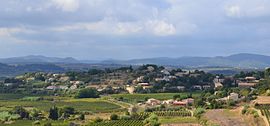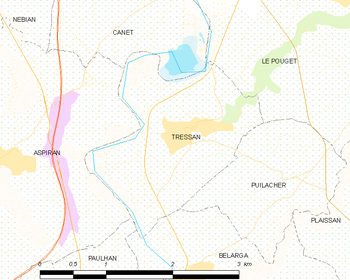Tressan
Tressan | |
|---|---|
 A general view of Tressan | |
| Coordinates: 43°34′32″N 3°29′27″E / 43.5756°N 3.4908°E | |
| Country | France |
| Region | Occitania |
| Department | Hérault |
| Arrondissement | Lodève |
| Canton | Gignac |
| Intercommunality | Vallée de l'Hérault |
| Government | |
| • Mayor (2020–2026) | Daniel Jaudon[1] |
Area 1 | 3.92 km2 (1.51 sq mi) |
| Population (2022)[2] | 688 |
| • Density | 180/km2 (450/sq mi) |
| Time zone | UTC+01:00 (CET) |
| • Summer (DST) | UTC+02:00 (CEST) |
| INSEE/Postal code | 34313 /34230 |
| Elevation | 17–100 m (56–328 ft) (avg. 80 m or 260 ft) |
| 1 French Land Register data, which excludes lakes, ponds, glaciers > 1 km2 (0.386 sq mi or 247 acres) and river estuaries. | |
Tressan (French pronunciation: [tʁɛsɑ̃]; Occitan: Treçan) is a commune in the Hérault department in the Occitanie region in southern France.
Subject to a Mediterranean climate, the area is drained by the Hérault and Dourbie rivers. The commune hosts remarkable natural heritage, featuring two natural areas of ecological, faunistic, and floristic interest (Zone naturelle d'intérêt écologique, faunistique et floristique, ZNIEFF). Tressan is a rural commune with a population of 684 as of 2021, following significant growth since 1975. It is part of the Montpellier attraction area. Its inhabitants are known as Tressanais (for men) and Tressanaises (for women).
Geography
[edit]
Tressan is located on the road between Gignac and Pézenas, extending across a hill in the Hérault Valley.
The neighboring communes are Canet, Le Pouget, Puilacher, Bélarga, Paulhan and Aspiran.
Climate
[edit]In 2010, the climate of the commune is classified as a frank Mediterranean climate, according to a study based on a dataset covering the 1971-2000 period.[3] In 2020, Météo-France published a typology of climates in mainland France in which the commune is exposed to a Mediterranean climate and is part of the Provence, Languedoc-Roussillon climatic region, characterized by low rainfall in summer, very good sunshine (2,600 h/year), a hot summer 21.5 °C (71 °F), very dry air in summer, dry conditions in all seasons, strong winds (with a frequency of 40 to 50% for winds > 5 m/s), and little fog.[4]
For the 1971-2000 period, the average annual temperature was 14.7 °C (58 °F) with an annual atmospheric temperature of 16.4 °C (62 °F). The average annual total rainfall during this period was 669 mm, with 6.1 days of precipitation in January and 2.7 days in July.[3] For the subsequent period of 1991 to 2020, the average annual temperature observed at the nearest weather station, located in the commune of Saint-André-de-Sangonis, 8 kilometres (5 mi) away as the crow flies,[5] is 15.5 °C (60 °F), and the average annual total rainfall is 652.4 mm.[6][7]
For the future, climate parameters for the commune projected for 2050, based on different greenhouse gas emission scenarios, can be consulted on a dedicated website published by Météo-France in November 2022.[8]
Urbanism
[edit]Typology
[edit]As of January 1, 2024, Tressan is classified as an ‘bourg rural’ (rural township) according to the new seven-level commune density grid established by Insee in 2022.[l 1] The commune is located outside of any urban unit.[l 2] Additionally, Tressan belongs to the Montpellier attraction area, where it is designated as a commuter town.[Note 1][l 2] This area, encompassing 161 communes, falls under the category of areas with 700,000 inhabitants or more (excluding Paris).[l 3]
Land Use
[edit]The land use in the commune, as recorded in the European biophysical land use database, Corine Land Cover (CLC), is characterized by agricultural areas (87.7% in 2018), an approximately equivalent proportion compared to that of 1990 (89.2%). The detailed distribution in 2018 was as follows: permanent crops (73.3%), heterogeneous agricultural areas (14.4%), urban areas (9%), shrub and/or herbaceous vegetation environments (2.8%), inland waters[Note 2] (0.5%).[9] Changes in the commune’s land use and infrastructure can be observed on various cartographic representations of the area: the Cassini map (18th century), the military topographic map (1820–1866), and IGN maps or aerial photographs from 1950 to the present day.[Map 1]

Population
[edit]Changes in the number of inhabitants have been documented through population censuses conducted in the commune since 1793. For communes with fewer than 10,000 inhabitants, a full census of the population is conducted every five years, with the legal populations for the intervening years estimated through interpolation or extrapolation.[10] For this commune, the first complete census under the new system was carried out in 2005.[11]
In 2021, the commune had a population of 684,[Note 3] reflecting an increase of +7.38% since 2015 (Hérault: +7.29%, France excluding Mayotte: +1.84%).
|
| |||||||||||||||||||||||||||||||||||||||||||||||||||||||||||||||||||||||||||||||||||||||||||||||||||||||||||||||||||||||||||
| Source: Ldh/EHESS/Cassini until 1999,[12] and INSEE since 2006.[13] | ||||||||||||||||||||||||||||||||||||||||||||||||||||||||||||||||||||||||||||||||||||||||||||||||||||||||||||||||||||||||||||
Notable people born in Tressan
[edit]See also
[edit]Notes and references
[edit]Notes and maps
[edit]Notes
[edit]- ^ The concept of an functional area replaced the former concept of an urban area in October 2020, enabling consistent comparisons with other European Union countries.
- ^ Inland waters refer to all surface waters, generally freshwater sourced from precipitation, that are located inland.
- ^ Legal municipal population effective as of January 1, 2024, based on 2021 data, defined within the territorial boundaries effective as of January 1, 2023, with a statistical reference date of January 1, 2021.
Maps
[edit]- ^ "Évolution comparée de l'occupation des sols de la commune sur cartes anciennes". remonterletemps.ign.fr (in French). Retrieved 3 November 2024.
References
[edit]Insee website
[edit]- ^ "La grille communale de densité". insee.fr (in French). 28 May 2024. Retrieved 26 October 2024.
- ^ a b "Métadonnées de la commune de Tressan". Insee (in French).
- ^ "Liste des communes composant l'aire d'attraction de Montpellier". insee.fr (in French). Retrieved 26 October 2024.
Other sources
[edit]- ^ "Répertoire national des élus: les maires" (in French). data.gouv.fr, Plateforme ouverte des données publiques françaises. 13 September 2022.
- ^ "Populations de référence 2022" (in French). The National Institute of Statistics and Economic Studies. 19 December 2024.
- ^ a b Joly, Daniel; Brossard, Thierry; Cardot, Hervé; Cavailhes, Jean; Hilal, Mohamed; Wavresky, Pierre (18 June 2010). "Climate Types in France: A Spatial Construction". Cybergéo, European Journal of Geography (501). doi:10.4000/cybergeo.23155. Retrieved 26 October 2024.
- ^ "Zonages climatiques en France métropolitaine". pluiesextremes.meteo.fr. Retrieved 25 October 2024.
- ^ "Orthodromie entre Tressan et Saint-André-de-Sangonis". fr.distance.to. Retrieved 25 October 2024.
- ^ "Station Météo-France « St Andre De Sangonis » (commune de Saint-André-de-Sangonis) - fiche climatologique - période 1991-2020" (PDF). donneespubliques.meteofrance.fr. Retrieved 25 October 2024.
- ^ "Station Météo-France « St Andre De Sangonis » (commune de Saint-André-de-Sangonis) - fiche de métadonnées" (PDF). donneespubliques.meteofrance.fr. Retrieved 25 October 2024.
- ^ "Climadiag Commune:diagnostiquez les enjeux climatiques de votre collectivité". meteofrance.fr (in French). November 2022. Retrieved 25 October 2024.
- ^ "CORINE Land Cover (CLC) - Répartition des superficies en 15 postes d'occupation des sols (métropole)". Data and Statistical Studies Portal of the Ministry of Ecological Transition (in French). Retrieved 3 November 2024.
- ^ "L'organisation du recensement". insee.fr.
- ^ "Calendrier départemental des recensements". insee.fr.
- ^ "Des villages de Cassini aux communes d'aujourd'hui". École des hautes études en sciences sociales (in French). Retrieved 25 October 2024.
- ^
Statistical data from INSEE for various years:
- 2006: INSEE 2006
- 2007: INSEE 2007
- 2008: INSEE 2008
- 2009: INSEE 2009
- 2010: INSEE 2010
- 2011: INSEE 2011
- 2012: INSEE 2012
- 2013: INSEE 2013
- 2014: INSEE 2014
- 2015: INSEE 2015
- 2016: INSEE 2016
- 2017: INSEE 2017
- 2018: INSEE 2018
- 2019: INSEE 2019
- 2020: INSEE 2020
- 2021: INSEE 2021




